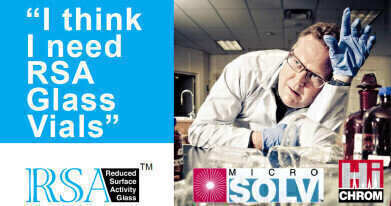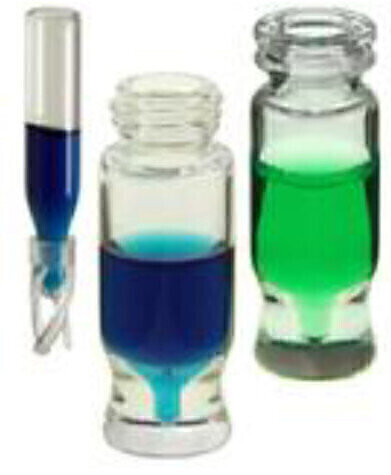Environmental laboratory
RSA Glass™ – Reduced Surface Activity Glass A next generation of glass reduces the interaction of analytes and the glass.
Dec 07 2011
• Detect Low Abundance Analytes Normally Adsorbed by Glass
• Prevent pH changes in vials before injection
• Prevent hydrolysis that can occur in your vials
• An excellent choice for GC and GCMS applications
Made with a new patent pending, glass manufacturing process, RSA Glass™ vials and inserts have reduced surface activity for basic compounds. This is due to the elimination of virtually all silanols (hydroxyl groups) that can have deleterious effects on your analytes and sample solutions.
RSA™ autosampler vials and glass inserts are not manufactured with coatings; but have significantly reduced silanols on the glass surface normally produced during the manufacturing process. This lack of surface silanols makes them an excellent choice for GC and GCMS applications.
With standard borosilicate glass vials and inserts sample diluents (such as water) can de-protonate the many surface hydroxyl groups; producing a negative charge on the glass wall. The “acidic” functionality of silanols has been known to cause adsorption of basic compounds, change the sample solution pH and/or hydrolyze susceptible compounds rendering them undetectable. With RSA Glass™ vials and inserts there is virtually no sample “loss to the vial” and no “pH shifting” making your analysis more reliable.
If you are working with low abundance basic samples with regular glass vials, it is very possible that your compounds could easily be adsorbed to the glass wall. This can change your quantitation or completely remove the compound from solution preventing injection and ultimately masking its detection and identification. With RSA Glass™ vials and inserts this will not occur if the adsorption is due to silanol interaction.
If you are working with sensitive compounds commonly found in natural products, biological samples or chemical synthesis, the glass wall could be a problem for basic compounds. With RSA Glass™ vials this problem is eliminated.
If you are working with basic proteins that adsorb or are affected by silanols; RSA Glass™ vials and inserts will be a good solution for you. If your proteins are sticking to the glass due to adsorption to the siloxane surface, RSA Glass™ provides an almost completely inert surface. The results of silanizing RSA Glass™ over standard borosilicate glass is far superior for proteins and peptides if this option is desired.
RSA Glass™ has been tested for metals that may cause sample or diluent contamination. It has ULTRA low levels of Sodium, Calcium, Aluminum and Boron. Sodium and Boron levels are 200 to 300 times less concentrated compared to leading manufacturers’ vials, with Calcium and Aluminum almost non-detectable. Testing was done using ICP with water from the vials and a 4 hour "soak" time.
There is no significant cost increase for RSA Glass™ vials and inserts. They are QC tested to meet or exceed any commercially “certified” vial or insert. That is our promise. Manufacturer MicroSolv. Patent Pending.
For further information on RSA vials contact Hichrom Limited, UK, Tel: +44 (0) 118 930 3660 technical@hichrom.co.uk or click here
Digital Edition
IET 35.2 March
April 2025
Air Monitoring - Probe Sampling in Hazardous Areas Under Extreme Conditions - New, Game-Changing Sensor for Methane Emissions - Blue Sky Thinking: a 50-year Retrospective on Technological Prog...
View all digital editions
Events
Apr 21 2025 Shanghai, China
Apr 22 2025 Hammamet, Tunisia
Apr 22 2025 Kintex, South Korea
Analytica Anacon India & IndiaLabExpo
Apr 23 2025 Mumbai, India
Apr 23 2025 Moscow, Russia




.jpg)


_(4427399123)-(2).jpg)














